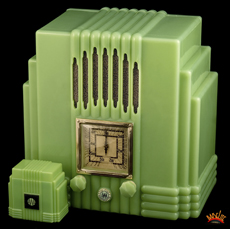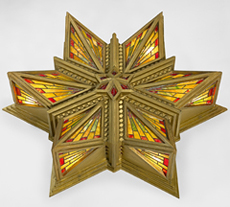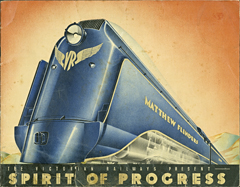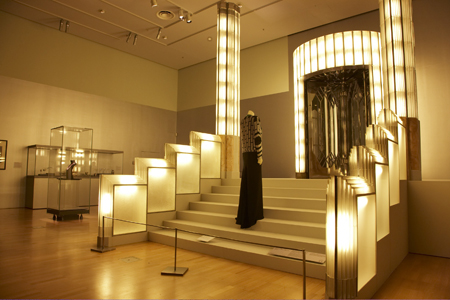review by Caroline Jordan
As students in Australia in the 1980s, my friends and I trawled op-shops for beaded evening bags, teacups with triangulated handles, concrete-look geometric wall vases, bakelite and marcasite jewellery and, although I never found one, the odd piece of highly collectible, garishly-painted Clarice Cliff 'Bizarre' pottery. A familiar feature of the student house of the period was one of those massive, built-to-last, Deco lounge suites upholstered in threadbare Genoa velvet in distressing shades of brown. An ashtray and drink stand was often to be found built into the armrests, a thoughtful addition. Still today, the local cinema in your suburb or country town is likely to be a down-at-heel Art Deco gem, as are walk-up flats from St Kilda to Coogee, the former corner bank building, the baby health centre, the memorial pool and the beach pavilion. More notable Deco buildings survive to grace our cities — Sydney's King George V Hospital, Canberra's Old Parliament House or Melbourne's Manchester Unity building — but we provincials missed out on the ultimate statement of a Chrysler or Empire State Building. Nonetheless, many of us are on familiar terms with New York glamour, too, through old black-and-white Hollywood movies that Bill Collins and others used to screen on late-night television. Fred Astaire and Ginger Rogers, Clark Gable and Jean Harlow, Myrna Loy and William Powell, courted each other in rapid-fire dialogue in dazzling mirrored apartments furnished with white telephones and polar bear rugs, and impressed themselves onto our dreams.
The pleasure and education to be derived from this monumental exhibition — superbly curated by Ghislaine Wood from the Victoria and Albert Museum, London, and expanded in collaboration with a curatorial team from the National Gallery of Victoria — is that it thoroughly addresses these extremes of Art Deco, both in its local and well-worn, and exotic and received versions. Its chief revelation for the Australian viewer will be the opulence of many of the items on display, a far remove from the tat-moderne of most of the product that made its way into Australian homes. The global coverage and careful attention to national nuances also impresses, as does the sheer dazzling range of stuff. Whether your thing is cars, radios, frocks, fashion illustration, jewellery, crockery, silver and glassware, objets d'art, printed fabrics, furniture, interior design, industrial design, costume design, travel posters or architecture, you will find it in this exhibition. If you thrill to luxury brand names — Lalique, Cartier, Mercedes, Orrefors, Chanel — you will be gratified, but you will also discover many more obscure producers that are equally fine.
made by AWA, Sydney
collection of Peter Sheridan and Jan Hatch, Sydney
© Peter Sheridan

designed by Walter Burley Griffin and Marion Mahoney Griffin
Capitol Theatre, RMIT University, Melbourne
Art Deco also maintained a lively dialogue with the avant-garde. It may have eschewed the functionalist and puritanical aspects of modernism, but that did not stop it from plundering the vocabulary of Cubism, Futurism, Constructivism, De Stijl and the rest for its own hedonistic, decorative and escapist ends. Small, and in themselves not particularly impressive, paintings by middle-of-the-road avant-garde painters such as Delaunay, Leger, the Purist Ozenfant and the Cubist Gleizes, make perfect sense when placed against brilliant pieces of applied and decorative arts — including costumes from the Ballets Russes —that borrow from their colour and stylised motifs, if not from their turgid theory.
At the heart of the exhibition is a suite of furnished salons evoking the pavilions of the Exposition Internationale des Arts Decoratifs et Industriels Modernes held in Paris in 1925. Art Deco derived its name from the expo, although surprisingly the familiar term only dates from the 1960s. It was a commercial gambit to demonstrate French dominance over its international rivals in fashion and other high-end goods, with a brief to highlight the modern and innovative. This they managed, despite good competition from some of the Europeans. The expo saw the incipient style at its most lavish, but also at its most confused and unformed, with many exhibiting eclectic and backward-looking interior schemes. In the slide show of the pavilions, the uncompromising modernism of Aleksandr Rodchenko's Soviet Worker's Club and Le Corbusier's Pavillon de L'Esprit Nouveau are a sadly missing antidote to this fluffy bourgeois mix.
Individual objects in this section reach a crescendo of virtuoso technique and over-the-top extravagance. One can only marvel at the decadence of a French drawing-room chair by André Groult, creepily clad in white stingray skin with a seat of sky-blue satin, or a nearby English writing desk by Edward Maufe of mahogany and ebony, which is not just painted silver but gilded all over in white gold leaf. Equally exquisite is the finely-etched glassware, a fashion familiar in debased version from a million suburban shower-screens and dividing doors.
Gorgeous Josephine Baker, nude but for an ostrich-feather tail and swathes of beads, charlestons exuberantly on a floor-to-ceiling screen. Suddenly the toast of Paris pauses to jerk her neck in imitation of a chicken and cross her eyes. Playing the erotic primitive-as-clown night after night must have brought on its dispiriting moments, but Baker's joie-de-vivre seems real. At only 19, perhaps she could afford it. Baker's looped performance is the lead-in to an exotic travel dimension. Under the sign of the ocean liner and against a backdrop of travel posters, a slide show transports us to Art Deco destinations from Shanghai to Auckland.
Museum Victoria, Melbourne

The final spacious room of the exhibition rings an emotionally uplifting change with the introduction of a jazzy soundtrack. At last this is the Deco we know best, of Depression-era mass-produced American streamlining and Australian art and artefacts. The room is dominated by a magnificent Prussian-blue 1937 Cord 812 Westchester automobile with chrome detailing; shiny, thrusting, a true fetish object, sourced from a Melbourne collector. Our homegrown Deco stars: Klytie Pate, Olive Cotton, Rayner Hoff, the Sydney Harbour Bridge, Napier and Christian Waller, as well as a slide show of suburban Australian Deco buildings, are no afterthought, but presented as a loving and integral part of the exhibition's generous vision.
This is one of the best-orchestrated blockbusters I have ever seen. Its great achievement lies in its seamless melding of Australian Art Deco with myriad other national variations, the detail subsumed in a wholly satisfying narrative journey. Rampant consumerist desire and nostalgia is shamelessly pandered to — how could it not be with such materials? — but it would be difficult for any visitor not to come away without a much-enlarged and enlightened view of the Deco style and its period. More than 200,000 people saw the exhibition in Melbourne, a deserved repeat of its previous brilliant successes in England, Canada, the United States and Japan.
Caroline Jordan is a lecturer in art history at La Trobe University.
| Institution: | National Gallery of Victoria, in association with the Victoria and Albert Museum, London |
| Exhibition team: | Ghislaine Wood, Victoria and Albert Museum, London National Gallery of Victoria team: Frances Lindsay, Amanda Dunsmore, Kirsty Grant, Tracey Judd Iva, Matthew Martin |
| Venue/dates: | National Gallery of Victoria, 28 June – 5 October 2008 |
| Publication: | Exhibition catalogue published by the Council of Trustees of the National Gallery of Victoria. A$59.95 hardcover, A$44.95 softcover |
